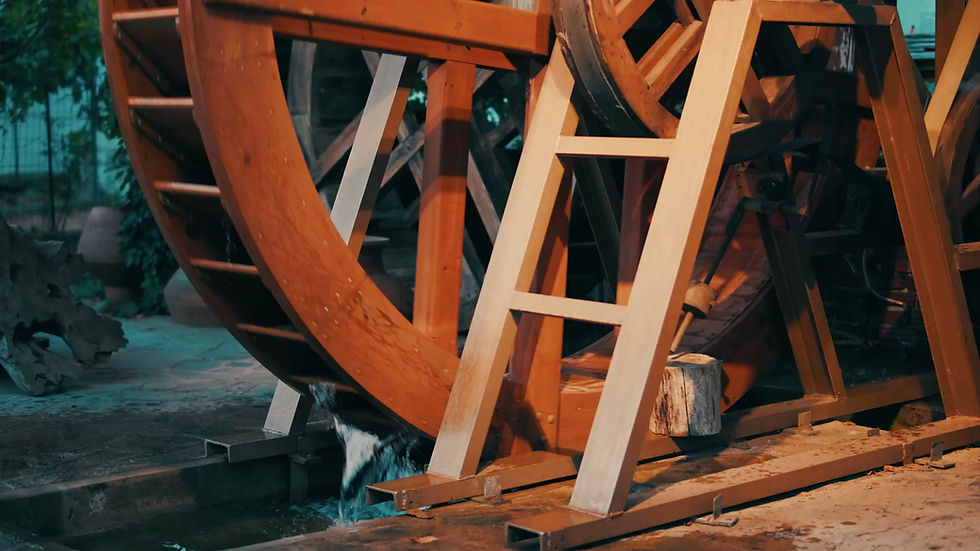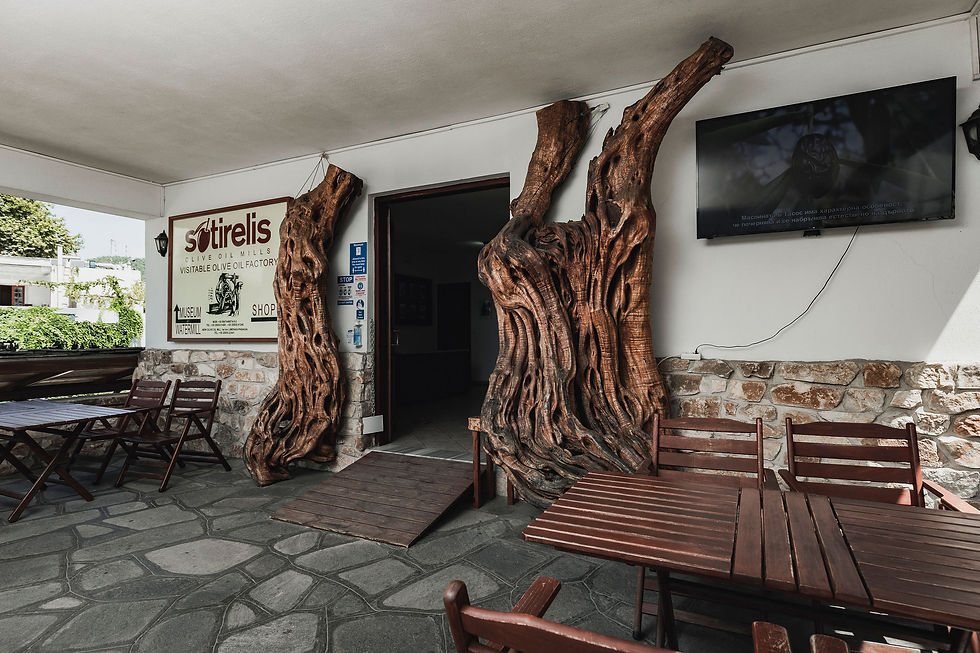
Museum
In the beautiful, traditional village of Panagia Thassos, at the visitable olive oil museum, we revitalize the history from the year 1915. Via audiovisual components in your native language, you will be informed about the most important local product on Thassos island… the extra virgin olive oil.
Organized guided tour is offered for groups of more than 20 people!
Reconstruction of the operation of an old water driven Olive press.
Sotirelis family have started to produce olive oil since 1915. In the begging electricity was not available on Thassos island so the machines used the power of water to operate. The water was coming from the three mountain springs of our village to power the mill.
Firstly the watermill (wheel) moved the millstones, while the rest of the work was manual.
In the early '30s the first hydraulic press (three column) was installed and used hydropower to operate as well.


Function
Water falls into the watermill which rotates. The movement is transmitted to the olive mill' s equipment with a system of pulleys and belts (straps) that are joined together in the main horizontal axis.
STONEMILLS - Grinding the olives into a paste
The olives (with the seed) are thrown into the millstones. The stone wheels rol in circles on a slab of granite to grind the olives into a paste. The paste is ground by the millstones for 30 minutes. During the grinding the olive oil and its aromas are released from the mesocarp cells. Each millstone receives 600 kg of olives and each wheel is made by granite and weighs 2 tons.


MALAXERS - Malaxing the paste
After grinding, the olive paste is transferred in the malaxers and is slowly mixed (stirred). The churning allows the microscopic droplets to form larger drops and be more easily separated. At that point, important factors are the malaxing time and the heating temperature.
DOSING DEVICE - Spreading the paste on olive mats
After malaxing, the olive paste is transferred on olive mats or fiber disks. A dosing-devise (proboscis) rotates and spreads an equable dose of olive paste on the mats. The mats are stacked on top of each other forming a pile. The pile, that contains 600 kg of olive paste, is placed on a special trolley and located into one of the three hydraulic presses. The disks act like filter and traditionally were made of coconut fiber and later of synthetic fibers suitable for food which is easier to clean and maintain


HYDRAULIC PRESSES
Separating liquids from solids
The paste-mats pile are placed into the hydraulic press. The hydraulic pistons press slowly the pile to the top with 400 atm pressure (650 tns power) and separate the solid from the liquid phase. The pressure procedure lasts 45 minutes. The solids that contain the core, skin and flesh remain between the mats and in this phase they are called pomace. After the pressing procedure the mats are flicked to remove pomace and be reused. The liquids that consist of olive oil and vegetable water, are gathered in tanks which lay behind and below the presses. These specific presses are a patent of Sotirelis family. In 1968 Sotiris Sotirelis and his son Nikolaos Sotirelis held (created) this patent as their modifications increase the oil yield and improve its quality
Separating olive oil from vegatable water
The olive liquids are transported to the separators. The operating principal of the separator is based on centrifugal power and on the difference of specific gravity of liquids (olive oil and vegetable water). During separation, a small water quantity is added to help the separation procedure. The temperature of the adding water is not higher than 27 ºC. The ending product is olive oil-virgin or extra virgin cold pressing olive oil.










Our olive oil mill which can be visited is located in the traditional village of Panagia on the island of Thassos.
Starting with the representation of the function of the olive oil mill with the use of the watermill and the water's motive force, into a realistic operation we revitalize the history since 1915. Adjacent the area with the full facilities of the traditional oil press, in operation until 2006, which offers the possibility to experience the technological advancements in the field of olive oil production. On the top floor of the specially designed area visitors can taste our olive oil, take specialized information, find pictures of all our historic evolution, material for olives and olive oil, and also a video projection showing the course from the olive tree to olives to olive oil.